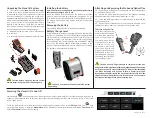
The Getinge SafeStep ATP Monitor unit has been
designed to meet the following general, safety and EMC
requirements:
General
• Low Voltage Directive 73/23/EEC
• EMC Directive 89/336/EEC
Safety
• BS EN 61010-1:2001, IEC 61010-1:2001
• UL 61010B-1
• CAN/CSA C22.2 1010.1-92
EMC
• EN 55022:1998 – Class B
• FCC CFR47 Pt15.109 – Class B
• EN 61000-4-3:1996
ESD
• N 61000-4-2:1995 + A1
The Getinge SafeStep ATP Monitor unit is manufactured
under ISO 9001 controls.
Declaration of Conformity
The Getinge SafeStep ATP Monitor unit has been designed
in accordance with, and satisfies the requirements of,
article 11 of the Low Voltage Directive 73/23/EEC as
realigned by 93/68/EEC on the harmonization of the laws
of the Member States relating to electrical equipment
designed for use within certain voltage limits, to the
essential requirements of BS EN 61010-1:2001.
The Getinge SafeStep ATP Monitor unit has been type
tested by EMC Projects Limited (a UKAS and CAA approved
test facility and UK appointed Notified Body), and issued
with a Certificate of Compliance No. 6349/07 to the
following EMC standard:
EN61326 : 1997
Covering:
• Radiated Emissions
(EN 55022:1998 – Class B)
• Electrostatic Discharge (FCC CFR47 Pt15.109 – Class B)
• Radiated Immunity
(EN 61000-4-3:1996)
• Electrostatic Discharge (EN 61000-4-2:1995 + A1)
Satisfying the EMC Directive(s) 89/336/EEC and 92/31/EEC
as realigned by 93/69/EEC.
Regulatory Limitations of Use
1. INTRODUCTION
1.1 Key Unit Features ................................................................
1.2 Accessories and Consumables .....................................
1.3 Principle of Operation .......................................................
2.BASIC UNIT OPERATION
2.1 Unit Description ..................................................................
2.2 Keypad Symbols .................................................................
2.3 Display Layout and Icons ................................................
2.4 Fitting the Batteries ...........................................................
2.5 Turning On the Unit ...........................................................
2.6 Low Battery Indicator .......................................................
2.7 Internal Self-Calibration ..................................................
2.8 Turning the Unit Of ............................................................
2.9 Power Saving Standby Mode .........................................
2.10 Low Memory Warning .....................................................
3. SAMPLE MEASUREMENTS AND TEST
RESULTS
3.1 Programmable Test Locations .......................................
3.2 Taking a Sample Measurement .....................................
3.3 Performing a Retest ..........................................................
3.4 Standby Mode .....................................................................
3.5 Bold Text ................................................................................
3.6 Save Tests .............................................................................
4. SET-UP MENU OPTIONS
4.1 User ID.....................................................................................
4.2 Setting Up Program Test Points
and Pass/Fail Limits .................................................................
4.3 Establishing ATP Pass/Fail Limits ................................
4.4 Viewing Stored Test Results ..........................................
4.5 Viewing Statistics Data and Test Failures ................
4.6 Erasing the Test Results Memory ................................
4.7 Setting the Clock Time and Date ..................................
4.8 Adjusting the LCD Contrast ..........................................
4.9 Quick Boot ............................................................................
5. UPLOADING TEST RESULTS TO A PC
5.1 Conditions of Use ...............................................................
5.2 System Requirements ......................................................
5.3 Installing the Software .....................................................
5.4 Software Functions ...........................................................
5.5 Registering Handheld Devices ......................................
5.6 Results Data File Format .................................................
6. OPERATOR MAINTENANCE
6.1 Cleaning the Casework ....................................................
6.2 Replacing the Batteries ....................................................
6.3 Cleaning and Replacing the Protective Pocket ......
7. TROUBLESHOOTING
7.1 Unit Beeps ..............................................................................
7.2 Troubleshooting Tips ........................................................
7.3 Unit Error Codes..................................................................
8. UNIT WARRANTY AND RETURNS
8.1 Warranty Duration ..............................................................
8.2 Particular Exclusion ..........................................................
9. GLOSSARY OF TERMS AND ABBREVIATIONS ...........
10. TECHNICAL SPECIFICATIONS
Table of Contents




































